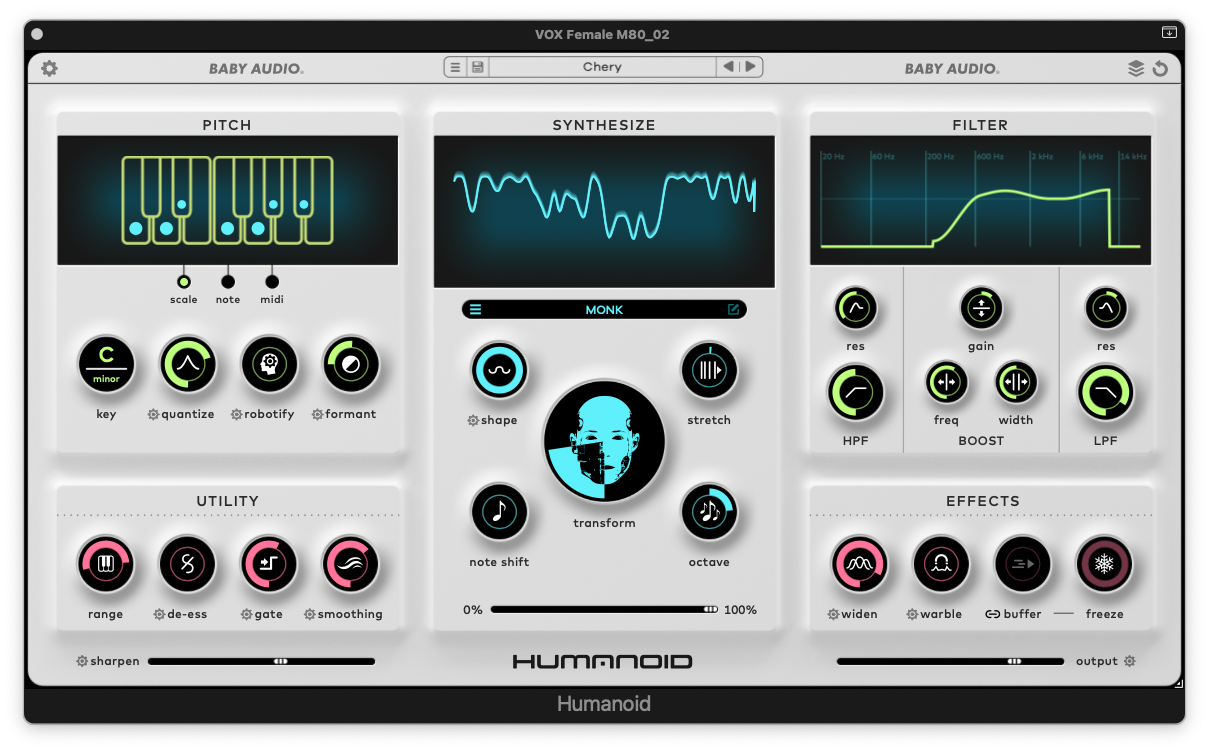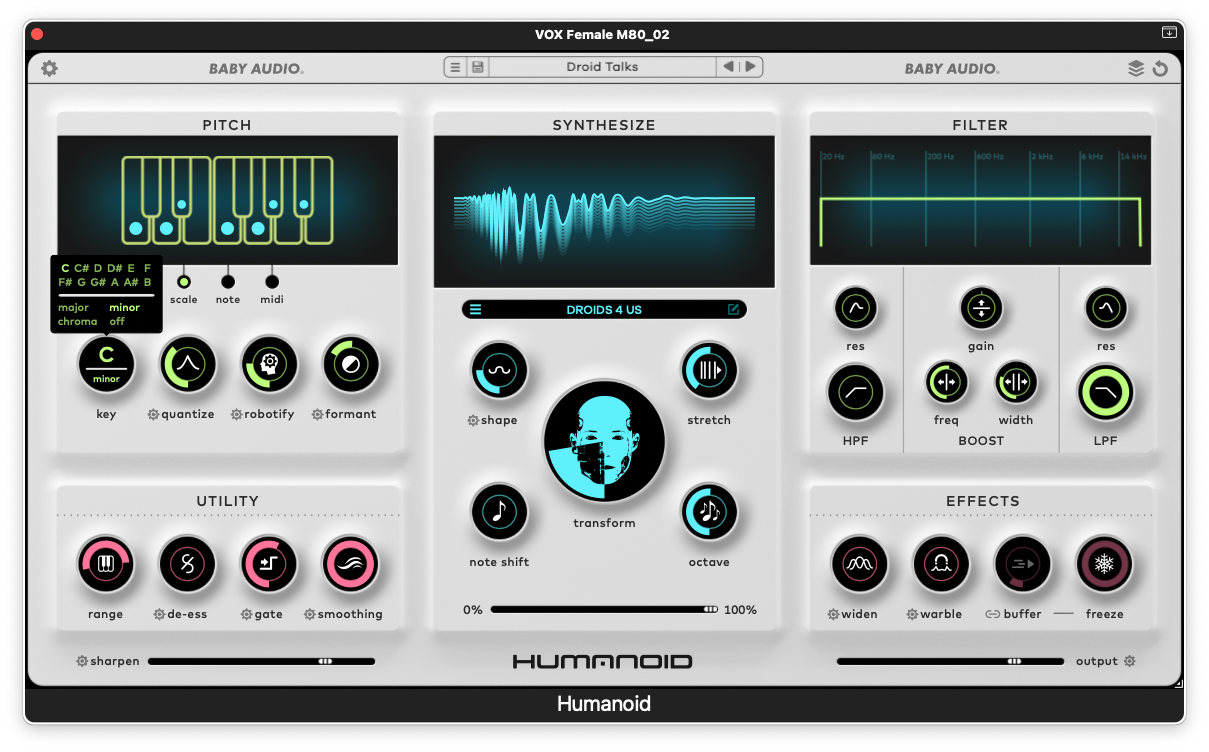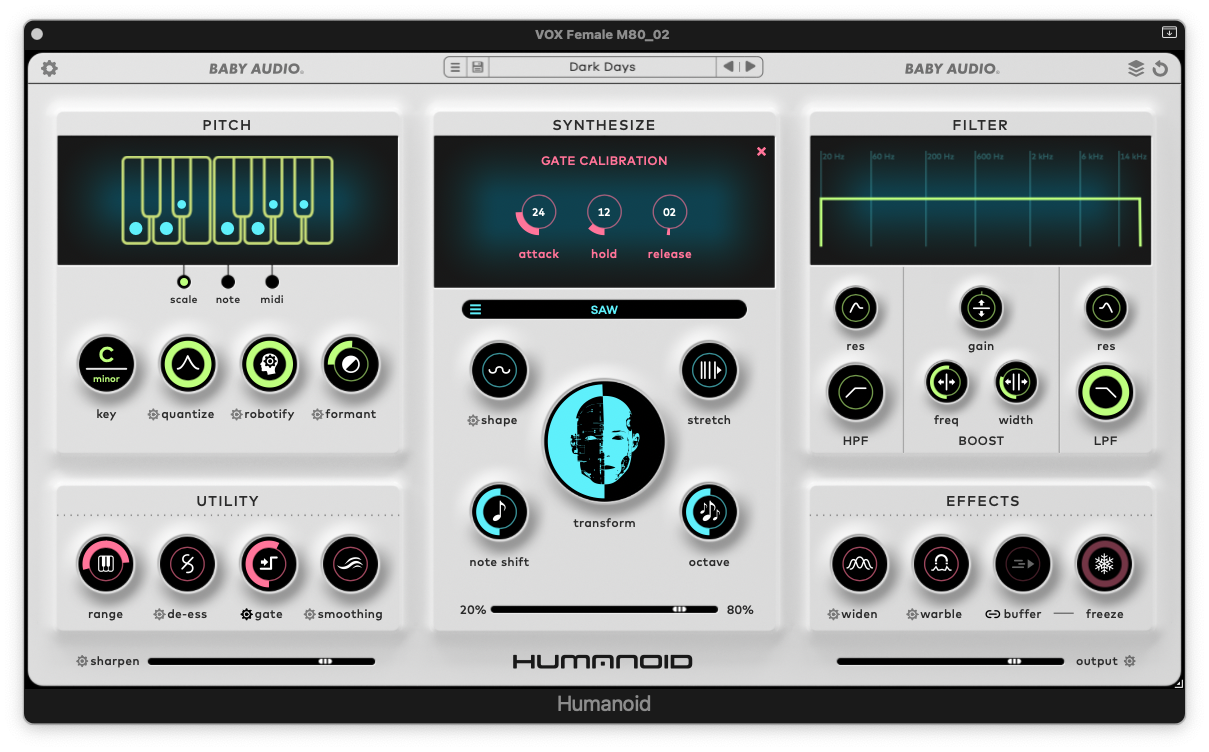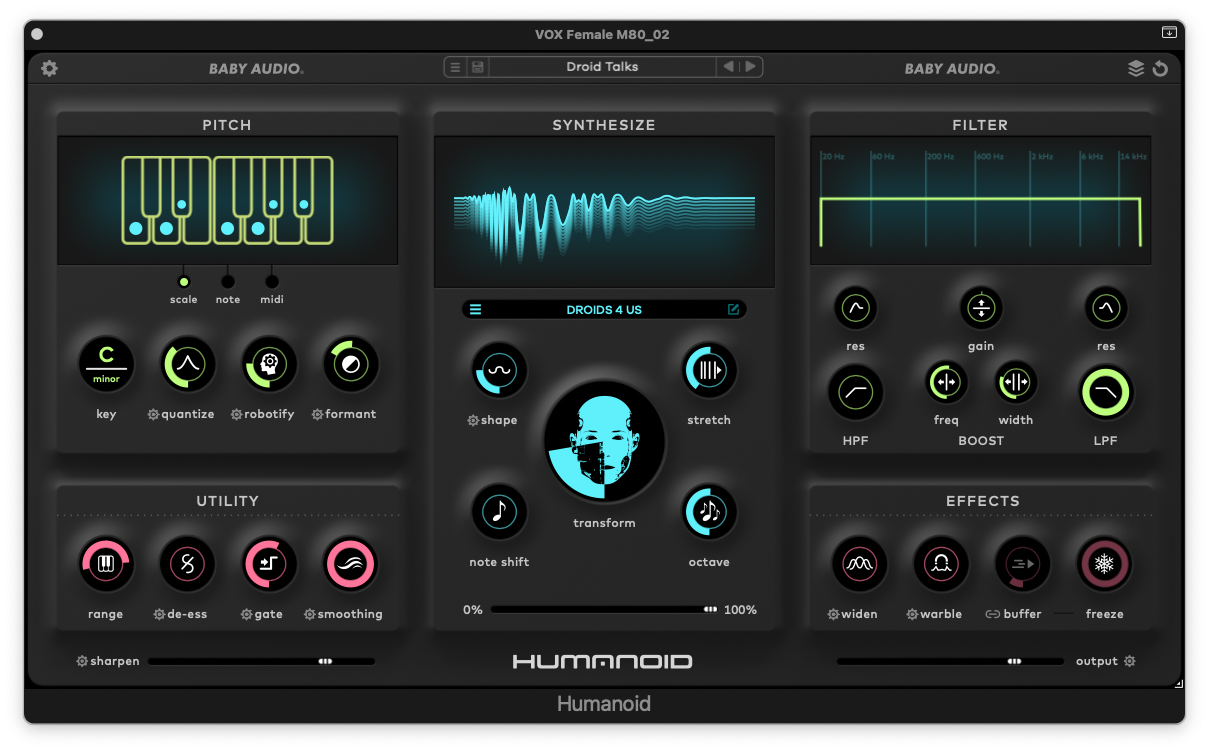Baby Audio Humanoid Review
- June 26, 2024
- by Steve Castellano
- Product Intelligence Report

Vocal tuning and pitch correction have become essential production tools for a wide variety of genres and it’s really no surprise – singers, composers and producers have been exploring the intersection of voices and machines since the dawn of electronic music. Into this category bucket, I will recklessly toss vocoders (first patented and demonstrated in 1939), talk boxes, harmonizers, the oddball EML Polybox, and of course latter-day vocal tuning plugins. Each tool approaches the task in its own way. And now there’s a new entry from Baby Audio called Humanoid, which takes some cues from its predecessors but ultimately heads off into uncharted territory.
Defying categorization
Baby Audio describes Humanoid as a “Vocal Transformer and Hard-Tuner Plugin,” establishing from the outset that while it can deftly handle your vocal tuning needs, it is more than just a utility. Being more of a keyboard vocoder kind of guy (Korg’s VC-10 was my version of the puppy in the pet store window as a youth), my first task was setting it up to give an isolated vocal track the Imogen Heap treatment. But I’m getting ahead of myself. If it’s like all these things but not, then what is it, exactly?

The user interface, like the Baby Audio plugins we’ve looked at in the past, is minimalist and intuitive, with a tactile-plastic look that you can almost feel. Light and dark themes are available from the settings menu. On the left is the Pitch section, where you can set a key from a preset scale or choose your available notes manually. Additional controls include quantize, which affects the strength of the pitch correction, robotify, which reconfigures harmonics to introduce a more synthetic timbre to your source material, and formant, which allows you to adjust the pitch of the vowel formants. This last one can help humanize things when using the note shift feature in particular.
That added touch
It's in the robotify control that we can really get a sense of what sets Humanoid apart from its predecessors, and how the plugin gets its name. An effect like a vocoder or talk box is a subtractive one, that shapes external sounds by selectively filtering out harmonics (in the latter case, the performer’s mouth is serving as kind of an analog filter, as it does for their own vocal cords). Humanoid analyzes and resynthesizes the input material before we even get to the Synthesize section, giving us a richer harmonic palette to play with.
Below the Pitch section is the Utility section, which offers controls to help refine the plugin’s response. Range, de-ess and gate can help you tame the source material and adjust clarity and intelligibility. Smoothing allows you to dial in a glide effect, for an alternative to the familiar stepped tuning effect. Many of Humanoid’s controls have their own micro-settings feature, indicated by a small gear icon beside the control label. These allow you to get under the hood and calibrate your control settings individually, much like the set-screw access points found on vintage hardware.

Scale, note and MIDI pitch modes
At the heart of Humanoid’s versatility are its three pitch selection modes. Scale mode operates as a typical hard-tuning plugin, quantizing incoming pitches to a preset scale. Note mode lets you set one or two fixed pitches that your source material will be quantized to, for a distinctly robotic effect. midi mode, as I teased above, is my personal favourite so far. You can use a real-time (or sequenced) MIDI input to play Humanoid like a keyboard vocoder, for advanced and conceivably impossible-to-sing choral arrangements. So among these three settings you have your Cher-bot, your Cylon centurion and your Laurie Anderson covers, well, covered.
Let’s synthesize!
The Synthesize section is where we leave traditional pitch correction in the rear view mirror. It is a polyphonic wavetable synthesis engine controlled by the amplitude envelope of the incoming signal and the pitches established by the Pitch section. The onboard waveforms range from basic analog shapes to more complex vocal-type timbres to pretty much anything you have kicking around on your audio drive, as there is an upload feature that lets you port over your favourite single-cycle waveform.

These source waveshapes can further be transformed using the shape and stretch controls for added timbral variety, and blended with the source signal using the big transform knob. Octave lets you dial in an octave above or below, and note shift provides a parallel voice that follows the scale set in the Pitch section. When used in conjunction with the midi pitch setting, things can get really thick, really fast. The synthesis engine is further complemented by a Filter section with resonant low and high pass filters, plus a parametric mid band that can serve as a notch or be boosted into saturation via the gain control.
Rounding out the front panel is an Effects section with widen (chorus), warble (vibrato) and freeze mode. Freeze lets you hold and repeat the last sound to pass through Humanoid, with a loop length determined by the buffer control. So there’s Max Headroom taken care of as well.
Conclusions
With Humanoid, Baby Audio has created a plugin with a deceptively simple interface that belies a surprising depth and power. I’d previously thought of pitch correction as an effect that’s either “in or out,” but Humanoid got me really excited about its musical potential right away. The diatonic note shift feature was a particularly pleasant surprise, and makes harmonization a snap. If I were to make any suggestions (helpfully, there’s a “suggest feature” option in the settings menu), I would say filters always sound best when they’re moving, so an envelope follower control for the filter section would be a welcome addition. But all cutoff frequencies are addressable by your DAW’s automation – along with all the other controls I’ve mentioned, including note selection and calibration settings – you should have no trouble getting Humanoid to move to your music.
Latest Music Software ReviewsAuthor

Steve Castellano
Steve Castellano is a musician and writer living in Toronto, Canada. He holds a music degree from York University, where his focus was electronic music and composition. He currently records and performs modular electronic music under the name Elettronica Sperimentale.